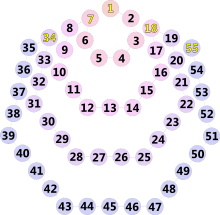Heptagonal number
A heptagonal number is a figurate number that represents a heptagon. The n-th heptagonal number is given by the formula
- .

The first few heptagonal numbers are:
- 1, 7, 18, 34, 55, 81, 112, 148, 189, 235, 286, 342, 403, 469, 540, 616, 697, 783, 874, 970, 1071, 1177, 1288, 1404, 1525, 1651, 1782, … (sequence A000566 in the OEIS)
Parity
The parity of heptagonal numbers follows the pattern odd-odd-even-even. Like square numbers, the digital root in base 10 of a heptagonal number can only be 1, 4, 7 or 9. Five times a heptagonal number, plus 1 equals a triangular number.
Generalized heptagonal numbers
A generalized heptagonal number is obtained by the formula
where Tn is the nth triangular number. The first few generalized heptagonal numbers are:
Every other generalized heptagonal number is a regular heptagonal number. Besides 1 and 70, no generalized heptagonal numbers are also Pell numbers.[1]
Sum of reciprocals
A formula for the sum of the reciprocals of the heptagonal numbers is given by:[2]
Heptagonal roots
In analogy to the square root of x, one can calculate the heptagonal root of x, meaning the number of terms in the sequence up to and including x.
The heptagonal root of x is given by the formula
Derivation of heptagonal root formula
The heptagonal roots n of x are derived by:
- (use quadratic formula to solve for n)
Rearrange this to:
and taking the only positive value gives the formula for n associated with a given x.
References
- ↑ B. Srinivasa Rao, "Heptagonal Numbers in the Pell Sequence and Diophantine equations " Fib. Quart. 43 3: 194
- ↑ Beyond the Basel Problem: Sums of Reciprocals of Figurate Numbers